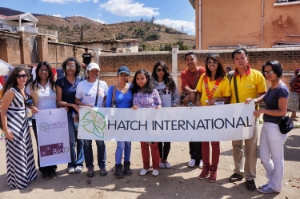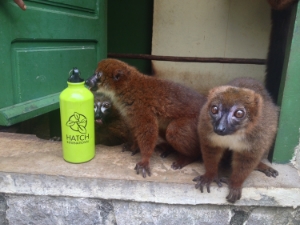
Antananarivo, the scenic capital of Madagascar
In August Rahul Mitra and I traveled to Madagascar for what I’m happy to report was a very successful pilot trip for BioD. The purpose of the trip was to install test units in a small group of consumer households before introducing the technology to a wider market. During the piloting phase, which will last six months, we will be collecting feedback from users on the ease of use, functionality, appearance, price, and product features. BioD researchers will conduct a baseline and endline household survey, as well as focus groups and remote intermittent monitoring. The data we collect during the piloting phase will be used to refine the technology so it meets the needs expressed by consumers.

IME Students and Professor Hery Rakotondramiarana with BioD Co-Director Caroline Angelo
Early in the project's development BioD formed important partnerships in Madagascar with the University of Antananarivo and Rotaract Club Avana, both of which were instrumental in the pilot's success. Under the guidance of engineering professors at the University of Antananarivo's Intitut pour le Matrise d'Energie (IME), the team met and collaborated with Masters and PhD students on the technical aspects of the design and the sourcing of parts in Madagascar. These students constructed the pilot units and will be performing measurements on and optimizing the current design. They will also periodically travel to the pilot sites to collect data and perform troubleshooting, as well as assist BioD in securing patent protection and incorporating the business in Madagascar.

Rotaract Avana during piloting in Ampefy
Comprised of young adults in Antananarivo, the Rotaract Club Avana’s mission is to improve their communities through service projects. An early supporter of BioD, they laid the groundwork for the pilot's success by identifying appropriate communities and providing sensitization and training to these communities prior to the installation of pilot units. During the trip they scheduled meetings with government agencies and NGOs, advertised the BioD through radio, print, and word of mouth, and hosted community meetings in the pilot villages. They will be working closely with the IME students and local Peace Corps volunteers, and will continue to support BioD by visiting the pilot communities to conduct household surveys and collect user feedback on the units.

This lemur was curious about what a Hatch water bottle tasted like
Our first visit was to Ampefy, an idyllic commune in the Itasy region, about 75 miles from the capital. Ampefy is rich in natural beauty, with waterfalls, geysers, and and a big lake that many of the residents’ homes are clustered around. Sadly, the gorgeous scenery of Ampefy belies a community of people that earn less than $1 a day and rely on smoke-producing fuels such as firewood and charcoal for cooking. Like most communes in Madagascar, the majority of its population earns a living through farming, though some are fishers. By far the freshest and most delicious fish we had was in Ampefy! One of the reasons we chose Ampefy is because there is a strong Peace Corps presence. Sarah, the charismatic volunteer currently assigned to Ampefy, was as enthusiastic about the BioD as we are and will assist us in collecting feedback and promoting the technology.

Owner of the BioD in Ampefy
We set up the BioD in the center of town, and quickly drew a crowd of curious onlookers who started asking questions about the strange-looking device. Rahul impressed everyone by giving a talk in Malagasy, while I opted to speak in English with a translator. We explained how the BioD works, and how it can save users time and money while reducing deforestation and the health hazards associated with cooking smoke. We concluded the demonstration with a Q&A session where community members asked a lot of great questions. Then the BioD was moved to the home of our first pilot participant, a woman who is Ampefy’s pioneer in alternative energy; in addition to hosting the inaugural BioD, she has solar panels installed on her roof!

Installation of the BioD in Ambohimanga
The second week we traveled to Ambohimanga, the site of one of Madagascar’s 12 sacred hills. This time we had BioD t-shirts made, and gave them out as prizes during a lively trivia session.
This was my first trip to Madagascar, so in addition to the excitement of the pilot itself, meeting our partners and customers face-to-face was an unforgettable experience for me. Madagascar is a beautiful country and the people were incredibly warm and friendly and made Rahul and me feel very welcome.

Budding photographer
One of my favorite memories was while we were in Ambohimanga. I handed my camera to a little girl, and after a very short lesson, she grasped the concept of how to take a picture. She proceeded to take a bunch of pictures of her friends and even a few of me; when Rahul and I looked at the pictures later, we were both amazed at how good they were! Her pictures were some of our favorites from the trip.

BioD with Catholic Relief Services
There are several things on the horizon for BioD. Through a planned partnership with Catholic Relief Services (CRS), BioD plans to install 20-30 units in the commune of Miary, near the southwest port city of Tulear in the Spring of 2015. CRS will be selling the BioD units to families participating in a five-year food distribution program at a subsidized price. We are currently working with CRS to source materials and identify manufacturing facilities in Tulear to lower construction and transportation costs.

BioD with Ministry of Energy

BioD with Peace Corps Madagascar
The team is also in the process of forming partnership agreements with several other organizations that we met with in Madagascar, including Madagascar Oil, the Ministry of Energy, the Office of Environment, Peace Corps Madagascar, BushProof, and Association Nationale d'Actions Environnementales (ANAE). These partnerships will assist in manufacturing, education, materials sourcing, and forming a business in Madagascar.
And finally, we have an exciting update on our coffee fundraising initiative. Based on feedback from experts in the United States, the team advised the Ampefy coffee cooperative on how to improve the quality of their product. This new and improved coffee was recently harvested and brought back to Washington, DC, where it will be roasted and sampled by local coffee shop owners (if you know any that might be interested in selling this delicious coffee, please let us know). Hopefully you will be able to try it for yourself soon!
We would like to thank everyone who donated during this summer’s fundraising campaign -- we wouldn’t have been able to accomplish all that we did on the pilot trip without your support!

Coffee cooperative with moisture analyzer provided by BioD
Hatch International’s BioD team has developed a low-cost and effective biodigester that converts organic waste into methane gas which can then be used as a cooking fuel in biodiversity-threatened nations such as Madagascar. The ultimate goal is to have a self-sustaining social enterprise run by a community within the next two years. For more information or to help support the project, please click here.
This blog post was written by Caroline Angelo, Co-Director of Hatch International’s BioD Project. Photos by Caroline Angelo and Rahul Mitra. More pictures from the trip can be found on Hatch’s Facebook page.